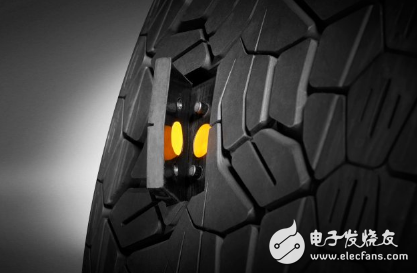As reported by Jessica Twentyman, the competition for smart tires has begun, and major manufacturers are relying on the Internet of Things to improve vehicle safety, improve fuel efficiency and extend tire life. It is very dangerous for a moving vehicle if the tire is worn or under-inflated. According to hightways England, the state-owned company responsible for maintaining and improving the British highway, in 2016, tire-related accidents on British roads killed 8 people and injured 120 people. Government data also shows that one of every 12 tires in a heavy-duty truck is under-inflated, and one out of every eight tires in the car is under-inflated, which may cause traffic jams and even serious catastrophic events. life threatening. In general, tires need to be smarter. The good news is that a lot of research work is currently underway in this area. Well-known tire manufacturers like Bridgestone, Michelin, Goodyear, and the mainland are trying to measure and monitor tire performance using IoT sensors and software platforms. For example, in late March, Continental Tire announced the launch of the ConTIConnect platform, a new digital tire monitoring platform for commercial fleets. Currently, it is only available to fleet operators in the US, Canada, Malaysia and Thailand, but the company says it will gradually expand to Europe and other parts of Asia. The ConTIConnect platform consists of three parts, the first being a tire sensor mounted on the tire lining to measure tire pressure and temperature. “Smart Tires†are purchased from Continental Tire Company and can be used in trucks, buses and earth-moving vehicles with sensors, but existing tires can also be retrofitted, either way, using Vodafone's IoT SIM technology. The second part of the system is the yard reading station, which is equivalent to a “gateway†installed on the company's premises for regular passage by commercial vehicles. For example, it can be installed in a washing plant, a gas station or a security checkpoint. The pick-up is a “bridge†between the tire sensor and the mainland company software platform. When the vehicle passes, it can read the data on the sensor and send it to the background for analysis. The third part is the basic software, which includes the portal, which can be used by fleet operator employees to monitor tires. For example, it shows the history of the tires so they can perform retrospective analysis. Also, when a specific issue is discovered and maintenance is required, the system will send a notification to the fleet manager via email or SMS. According to Paul Williams, executive vice president of commercial vehicle tires for the Americas region in the Americas, this means that vehicles are running longer and require less time to maintain. He said: "The team no longer needs to check tire pressure on dozens, hundreds or even thousands of tires one by one. With the ConTIConnect platform, they will immediately know if there is any tire pressure after returning to the team, and they can be protected by the Internet of Things. Tires save time and money for the team and increase the safety of the driver." Monitoring tire pressure and temperature is just the beginning, and smart IoT tires can also collect data such as road conditions or driver behavior. Did the truck run over the potholes when it last traveled? Does the driver have frequent brakes? In addition, smart tires can adjust the pressure and width of the tires to suit different driving conditions, such as according to the snowstorm conditions. Adjustment. While many commercial vehicles already have some tire pressure monitoring systems (TPMS) installed and are usually supplied by vehicle manufacturers, many systems can only cope with catastrophic failures, such as tires being nailed or potholes causing punctures. The IoT approach makes sense for the continuous data and range of data it provides. Therefore, the competition to create smarter tires is going on. For example, at the Geneva International Motor Show, Pirelli launched the Cyber ​​Car strategy, which allows each tire to interact with the onboard computer for safer, more economical driving. Pirelli claims that the first tires with the Cyber ​​Car system will be launched later this year, and some automakers are already working to integrate the new tire technology into their own in-vehicle "information entertainment" systems. Also at the Geneva show, Goodyear went further and showed the concept tire "oxyne", which has live moss inside. These mosses can rely on the unique design of the tread to absorb moisture from the road and with carbon dioxide in the air. In combination, photosynthesis is carried out under the sun's rays, generating oxygen and releasing it into the air. Interestingly, it is said that tires use optical communication (LiFi) to provide high-capacity mobile connectivity, connect tires to the Internet of Things, and enable them to interact with on-board computers. Oxyne may still have a way to go, but earlier this year, Goodyear launched Tire Optix, a subscription-based tire management program that integrates sensors, mobile applications and cloud-based platforms like the continconnect platform. . Not only do tire manufacturers want to retrofit their wheels with new smart tires, Microsoft announced last week that it plans to spend $5 billion on the IoT project over the next four years. The software giant also revealed that a Tire Express start-up in India The Azure IOT platform is being used to serve fleet operators. Microsoft announced: "The new IoT platform helps monitor tire performance in real time, helping customers take appropriate actions to improve operational efficiency, reduce costs and increase profitability." He also pointed out that driving a vehicle with a tire pressure below 20% of normal pressure would increase fuel consumption by 5-10% and tire life by 15-20%. This is very important for fleet operators. Tire costs are usually second only to fuel costs. A technology that extends tire life, improves fuel efficiency and increases safety will not disappoint fleet operators. Fork Type Connecting Terminals Fork Type Connecting Terminals,Terminals,Connecting Terminals Taixing Longyi Terminals Co.,Ltd. , https://www.longyicopperlugs.com